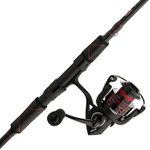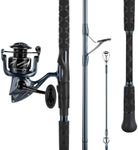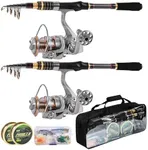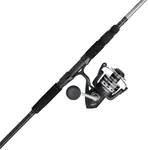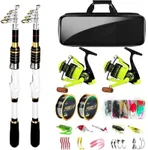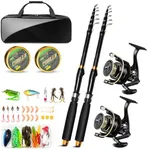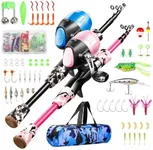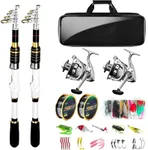Buying Guide for the Best Surf Fishing Combo
Choosing the right surf fishing combo can make a significant difference in your fishing experience. A surf fishing combo typically includes a rod and reel that are designed to work together, making it easier for you to get started. When selecting a surf fishing combo, it's important to consider several key specifications to ensure you get the best fit for your needs. Understanding these specs will help you make an informed decision and enjoy your time fishing on the beach or shoreline.Rod LengthRod length is the measurement from the tip of the rod to the butt. It is important because it affects casting distance and leverage when fighting fish. Surf fishing rods typically range from 8 to 15 feet. Shorter rods (8-10 feet) are easier to handle and are suitable for smaller fish and shorter casting distances. Medium-length rods (10-12 feet) offer a balance between casting distance and control, making them versatile for various conditions. Longer rods (12-15 feet) provide maximum casting distance and are ideal for reaching deeper waters and targeting larger fish. Choose a rod length based on the type of fish you are targeting and the distance you need to cast.
Rod PowerRod power refers to the rod's ability to handle different weights and sizes of fish. It is categorized as light, medium, medium-heavy, and heavy. Light power rods are suitable for small fish and light lures, while medium power rods can handle a wider range of fish sizes and lure weights. Medium-heavy and heavy power rods are designed for larger fish and heavier lures. Consider the size of the fish you are targeting and the type of bait or lures you will be using when selecting the rod power. For surf fishing, medium to medium-heavy power rods are often a good choice for versatility.
Rod ActionRod action describes how much and where the rod bends when pressure is applied. It is classified as slow, moderate, and fast. Slow action rods bend throughout the entire length, providing a more flexible and forgiving feel, which is good for casting light baits and fighting small fish. Moderate action rods bend in the middle, offering a balance between flexibility and stiffness, making them suitable for a variety of fishing situations. Fast action rods bend mostly at the tip, providing quick hook sets and better sensitivity, ideal for targeting larger fish. Choose the rod action based on your fishing style and the type of fish you are targeting.
Reel TypeThe reel type is crucial for surf fishing, as it affects casting distance, line capacity, and ease of use. The two main types of reels for surf fishing are spinning reels and conventional (baitcasting) reels. Spinning reels are user-friendly, versatile, and suitable for beginners and experienced anglers alike. They are great for casting lighter baits and handling various fish sizes. Conventional reels offer greater line capacity and are better for targeting larger fish and casting heavier baits, but they require more skill to use effectively. Choose a reel type based on your experience level and the type of fishing you plan to do.
Line CapacityLine capacity refers to the amount of fishing line that the reel can hold. It is important because it determines how much line you have available for casting and fighting fish. Surf fishing often requires long casts and the ability to handle strong, running fish, so having sufficient line capacity is crucial. Reels with higher line capacity can hold more line, which is beneficial for targeting larger fish and fishing in deeper waters. Consider the type of fish you are targeting and the fishing conditions when selecting a reel with the appropriate line capacity.
Material and DurabilityThe material and durability of the rod and reel are important for ensuring longevity and performance in harsh surf fishing conditions. Rods are typically made from graphite, fiberglass, or a combination of both. Graphite rods are lightweight and sensitive, making them ideal for detecting bites, while fiberglass rods are more durable and flexible, suitable for handling larger fish. Reels are often made from materials like aluminum, graphite, or stainless steel, which provide strength and resistance to corrosion. Choose materials that offer a good balance of sensitivity, strength, and durability based on your fishing needs and the environment you will be fishing in.




